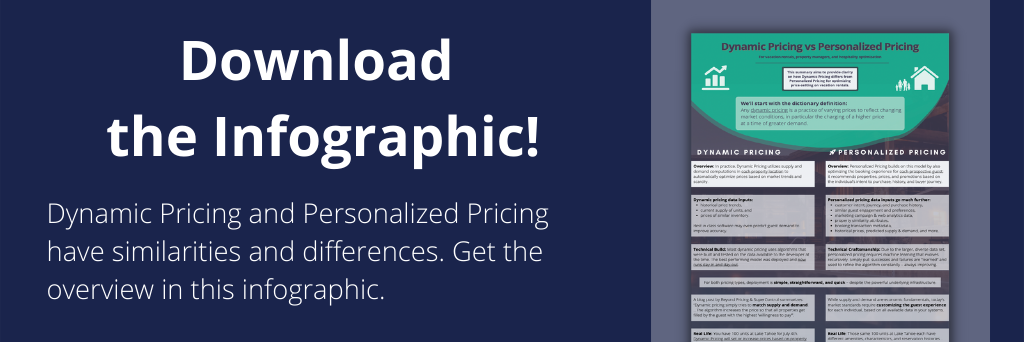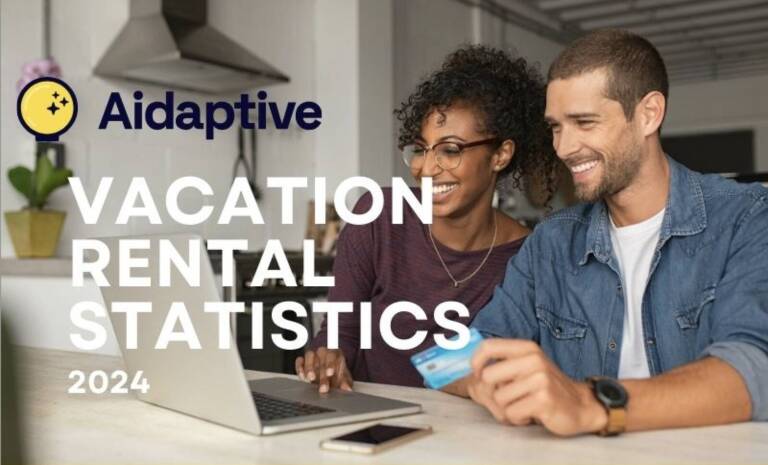Introduction
The Forbes post titled “Understanding The Future Of Dynamic Pricing“ from November 24, 2021 shined a bright and direct light on the disruption underway in the real estate pricing space.
It piqued our interest as it highlights the importance and impact of machine learning on two fronts: A) changing how pricing automation functions, and B) as a means to create a more individualized customer experience with vacation rental managers driving online bookings.
In this post we’ll share a recap of the article with takeaways – plus our analysis on the applications we’re seeing from this shift in methodology.
Article Summary
While we encourage you to read the article (linked here), we’ll provide our own quick summary.
The article paints the picture of a post-COVID-19 housing market – both for real estate buying and selling, and for vacation rental bookings. The changes have been huge in scope and drastic in the price and demand swings – but it argues the biggest changes are coming from the learnings and reflections of the actual managers & practitioners on the ground.
Traditional dynamic pricing has been very effective and successful for many years, and it’s described as a function of supply and demand fundamentals. The article dubs dynamic pricing as “supply-side pricing”, where in a given market “a home was priced at a comparison level as compared to other similar homes.”
But notably, the technology supporting this supply-side dynamic pricing was built out to support that paradigm.
These tools started by aggregating the data and making these comparisons extremely quickly, efficiently, and accurately. The software was able to “use increasing data sets to highlight subtle value differences between particular homes in a given market.”
We’d summarize this as nothing less than an enormous step up: in time-saving efficiency, accurate and fair price setting, and even supporting revenue-maximization.
But here is where the article hits an inflection point… it recognizes a scenario where price-setting can be based on much more specific data related to the renter and her customer-profile and preferences.
This powerful quote introduces the value of machine learning into the mix:
“It likely comes as no surprise that different homes are worth different prices to different people for different reasons at different times. That much is fairly obvious, but the challenge, for so long, has been taking that clear idea and finding with any real probability that one person at the right time with the right attribute in a scalable way. That’s where machine learning is breaking new ground, particularly at scale across large volumes of transactions and data sets.”
So the claim is: when machine learning is applied to certain data sets (the right data… organized in the right way), it provides us the ability to understand the relationships in terms of probabilities. And those probabilities change the game for matching any property in a market to highly probable buyers or renters – based on attributes, preferences, willingness to pay, etc.
More eloquently from Forbes: “In other words, machine learning technologies are making predicted price outcomes much more likely within addressable markets and time constraints.”
So while the previous paradigm of dynamic pricing was called supply-side pricing, the article dubs this new paradigm Personalized Pricing, as it is “based not necessarily on the home first but on the potential buyer first.”
The article also highlights the additional differentiator machine learning offers: speed to market.
The Forbes article talks about the potential here as a disruption of the status quo: “When we combine personal purchase knowledge of potential buyers with speed in trend analysis, we have a price disruption capability that we are only beginning to see.”
It’s important to note that the positive effects for vacation rental managers and real estate businesses that are possible using machine learning technology needs to be balanced with any potential negative side effects, like discriminating between demographic groups, or diminishing privacy on smartphones, etc.
The artificial intelligence (AI) and machine learning (ML) applications for business sales and marketing efforts have enormous potential; however, we learned from this article that the adoption by businesses is actually very low. “Duke University’s Fuqua School of Business suggested that only about 3% of survey respondents indicated their firms deployed AI / ML in their marketing regularly. Clearly, we are only seeing the early edge of this transformative technology reach our lives as we consider the buying and selling of real estate.”
So in short, the possibility is here for those who are looking to take the next step applying ML to personalize price recommendations to prospective renters.
Analysis and Opinions
We’re excited
Here at Jarvis ML, we were surprised and thrilled to see this article hit Forbes.
Why? Because this type of machine learning optimization is exactly at the core of what our software product does. And further, Jarvis ML is focused on enabling vacation rental management companies to drive better revenue and conversion rates through the personalization that’s possible with all this data and ML.
In the spirit of transparency, I’ve shared our involvement explicitly because Jarvis ML’s place in the creation of personalized pricing through machine learning colors our analysis of the article quite strongly.
Overview
Overall this was a thoughtful take on the future of pricing in the real estate and hospitality sectors. The article wasn’t afraid to speak candidly and directly about the nature of these changes, the benefits, the historical limitations, and the future potential risks.
Machine learning has become a buzzword within the last 5-7 years, but it’s applications are ever-growing as other infrastructure is improved. Some of the best machine learning in the world is being built and designed at large technology companies to tackle very complex and important business challenges.
Google is likely the leader in machine learning, as it has such an immense amount of data available to work with. Frankly, the amount of data is unfathomable. More data enables more training and more use cases for machine learning. (And of course, they have the resources to hire and pay the best developers, software engineers, and statisticians to figure it all out.)
ML technology is being built and used out in the world for a wide variety of use cases already, in a big way.
Google’s Ad platform has incredible machine learning behind the scenes, as does its Search results, Fraud detection, and many other areas.
Self-driving cars all use machine learning to train the car’s computer on the 3D environment and how to behave – or not – in a way that improves iteratively.
Machine learning also powers the recommendation engines behind Netflix and Pintrest, as well as smartphone apps that do face recognition and beyond.
But the key takeaway here is this:
- Machine learning is being wielded by some of the most powerful enterprises in the world to improve user experience, create personalized touches, enable really powerful technological breakthroughs, and create a ton of revenue.
- That type of functionality should be a very welcome addition to smaller companies in the VRM/RE space trying to do optimization and real-time learning on rental prices.
It’s about time that the power of machine learning was recognized by the real estate and vacation rental management sectors and put to work.
Probabilities are the future
Applying rigorous statistics to big data sets has been in place for a very long time. But the data sets we’re seeing now are much, much larger and take a lot more time to work through.
The statistical models that are involved in modern machine learning solutions are conceptually the same as they have been. There are best practices that shouldn’t be reinvented – the core differentiator is twofold:
- A) being able to process the large quantity of data in statistically relevant ways with high processing power, low latency (delay), and generate predictions at an extremely granular level, and
- B) utilizing self-guided decision making, where the software isn’t explicitly programmed to execute tasks. Rather it’s given guidance about the inputs and the goals, but designed to pave the best path to results… and then learn over time from each decision.
So when the article says “the challenge, for so long, has been taking that clear idea and finding with any real probability that one person at the right time with the right attribute in a scalable way,” – that challenge is now addressed. We have a scalable way to calculate those person-specific probabilities.
And that capability will only improve over time.
Supply-side, dynamic pricing
As already mentioned while summarizing the article above, the new affordances that arrived with dynamic pricing technology were an incredible game-changer for the industry. We love the way that the article phrases it – for two reasons.
First. “Supply-side” is descriptive of what’s going on. The dictionary definition of Dynamic Pricing tell us it is a practice of varying prices to reflect changing market conditions, in particular the charging of a higher price at a time of greater demand. Housing supply and demand gets wrapped up into that market price.
So it’s based only on the supply; it does not take into account the customer-centric approach, just the property-centric data.
Second. It explains that the technology was mainly used to quickly aggregate comparisons and use more data to “highlight subtle value differences between particular homes in a given market.” That paints a nice picture of what type of optimization is happening behind the scenes.
But of course, with the ability to utilize different types of data – namely that of the customer journey, purchase history, preferences, transaction metadata, and interactions on your website (etc) – there is an opportunity to operate in a new way. That data can be pushed through machine learning models to find more personalized recommendations for properties and prices and timeframes for your prospective guests.
Beyond that, new standards are being set by both customers and investors – for a more individualized experience and more profitability, respectively.
This future of dynamic pricing truly is in personalization.
A note on sophistication
The article uses fairly sophisticated language to explain the market concepts at play and how they are shifting. While the technical pieces of machine learning can be esoteric, the outputs can be very straightforward.
We don’t want to give the impression that machine learning isn’t complicated – but we do want to reassure that plugging an ML system into your data and other business systems can be straightforward. Deploying the ML into pricing calculations, email promotions, or your website can turn around and start improving business results very quickly: just a few weeks from scoping to revenue-impact.
Conclusion
The future of dynamic pricing is here. The fundamentals of supply-side pricing are tried and true, but the methodology lacks new types of inputs, infrastructure, and processing.
At Jarvis ML, we believe personalized pricing will replace dynamic pricing for any vendor that has a CRM or property management system that contains information about their customer. Or, even higher in the funnel, an understanding of their website visitors (prospective customers) through Google Analytics tracking is sufficient to get started.
With some kind of information about both properties and customers, real meaningful change is possible with machine learning.



